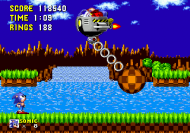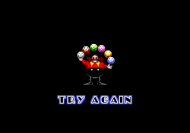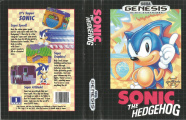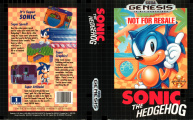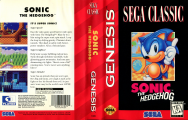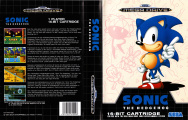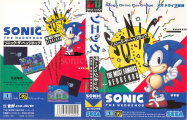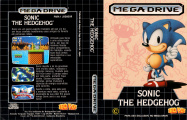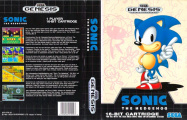Sonic the Hedgehog (16-bit)
From Sonic Retro
Revision as of 06:46, 22 March 2011 by Black Squirrel (talk | contribs)
- "Sonic 1" redirects here. For the Master System/Game Gear version, see Sonic the Hedgehog (8-bit). For other games with the same title, see Sonic the Hedgehog (disambiguation).
| Sonic the Hedgehog |
|---|
| System(s): Sega Mega Drive/Genesis |
| Publisher: Sega |
| Developer: Sonic Team |
| ROM size: 512 Kilobytes |
| Peripherals supported: N/A |
| Genre: 2D Platform |
Sonic the Hedgehog (ソニック・ザ・ヘッジホッグ) is the first game in the long-running series by videogame publisher and former console maker Sega. First released in the United States on June 23rd, 1991, it was the premier outing for the character of Sonic the Hedgehog and the group behind his creation, Sonic Team. Though the game only received marginal success in its home country, almost overnight Sonic became a sensation in the west, solidifying Sega's place in Europe and turning the company into a household name in the United States.
For the first time, a company was able to directly compete with console and gamemaker Nintendo, which had dominated the second half of the 1980's. Though Nintendo still reigned supreme in Japan, the highly-contested 16-bit wars in the west was a marvel to behold, the big two being neck and neck through almost the entirety of the third generation of console gaming.
The game propelled the creators into the realm of videogame superstardom, programmer Yuji Naka for a time becoming the face of Sega much as Shigeru Miyamoto became the face of Nintendo after the success of Super Mario Bros. The franchise took off, with a version of the game being released on the Sega Master System and a series of sequels across Sega's various consoles over the years. It not only became the definitive title for the system and replaced Altered Beast as the pack-in title for the west, but would go on to be ported to no less than twenty platforms since its initial release.
Contents
Story
Somewhere in the ocean lies a mysterious island not found on any map, known by its inhabitants as South Island. The reason for it being absent is a simple, yet mysterious one: it does not have a fixed position, instead traveling through the seas on its own course. While the reason for this behavior is unknown, it is rumored that it may have something to do with the legendary gemstones the Chaos Emeralds. Though legend says they exist on the island, no one knows exactly where they are or how to get a hold of them. All they do know is of the incredible power they are said to contain, and how they can give energy to all living beings.
Learning of the existence of the Chaos Emeralds, the mad genius Dr. Eggman sets himself on a quest to locate the emeralds for his own use, wanting to harness their power for his many mechanical creations. With the plan in motion, Eggman creates his base in a corner of the island, which he dubs the Scrap Brain Zone. However, he is aware that his evil plans will more than likely be interfered by Sonic the Hedgehog.
Though not a native of the island, Sonic the Hedgehog would often find himself on its mystical shores, and more than once had he run into the evil doctor, foiling an untold number of schemes. Just as Eggman predicted, in no time at all the blue hedgehog learns of the doctor's intentions, running at sonic-speed to confront him.
It doesn't take long for Sonic to realize that something is amiss, and is shocked to learned that Eggman has gone a step further with his evil intentions. Kidnapping the many animals living on the island, he has methodically been placing them in robot shells and using them to scour the island in search of the emeralds. Realizing that Eggman has turned Sonic's friends into his own personal mechanical army, Sonic wastes no time. Running across the island, he must not only stop Eggman's latest scheme and gather the Chaos Emeralds, but free his friends in the process.
"Hurry! Sonic the Hedgehog - everyone is waiting for your help!"
Game Mechanics
Gameplay
At its heart, Sonic the Hedgehog is a platformer. Taken from the same mold as platformers previous, Sonic Team was able to make the experience unique enough to rise it above the numerous Super Mario clones that had polluted the market. Becoming the standard for the Mega Drive, the game was also developed to showcase the potential of the system, creating a game that is simple to pick up but complex and engaging underneath.
Broken up into six "Zones" with three "Acts" each (and a final boss confrontation at the end), the game operates under a very basic platforming premise: to traverse across each level under a certain amount of time (in this case ten minutes) and overcome whatever enemies and obstacles may be in your way. The flow of each world presents an interesting duality in terms of playthrough. While it is possible to go through each act slow and methodically, it is just as simple to run through the zone as fast as possible, playing for the shortest time as opposed to the highest score. Featuring multiple pathways and plenty of secret areas, the eighteen main courses were created specifically with replayability in mind, Game Director Hirokazu Yasuhara wanting more than a basic arcade experience but instead a game that could stand the test of time.
Thanks to the efforts of Yuji Naka, the engine for which Sonic the Hedgehog is powered focuses not only on the potential speed for the character, but establishes the physics for the world as well. Being one part "pinball" and one part "momentum," the movement of Sonic depends just as much on the unique terrain of each level as it does on the input of the player. When it comes to the now-iconic set pieces of loop-de-loops and curved slopes, Sonic can only run through them if he has built up enough momentum to traverse through it. Running on curved slopes, a player can press downward on the control pad, allowing Sonic to curl up into a ball and gain tremendous speed - the steeper the slope, the higher the max speed at the end. Even the angles for which Sonic bounces off bumpers and springs are determined by the values within, making the Sonic experience unique from what other games were presenting at the time.
In terms of the moveset, the original Sonic the Hedgehog chooses to keep it simple. A secondary button is not needed to increase Sonic's speed, only time. Each of the three buttons on the Mega Drive controller were mapped to the same action, giving the player the power to make Sonic jump up, curling into a ball in the process. With this spin attack, Sonic can break an enemy from any angle, provided a spiked surface or a fire projectile is not in the way. He can also curl into this ball from on the ground, but can only remain as long as there is some momentum behind it. Once Sonic slows down, he is forced to return to his classic standing pose.
Scattered throughout each level are also a variety of items, the most famous of these being the spinning golden rings. While collecting one hundred of these will award Sonic with an extra life, they serve a much more important function. As long as Sonic has at least one in his possession, he can not be killed by an enemy or spikes, though he can still succumb to crushing and drowning. Being hit while having rings causes them to scatter, making Sonic temporarily invincible to give the player time to recover and try to collect the scattered rings before they disappear.
Another prominent item featured in each zone are the variety of item boxes in the game. Resembling computer monitors, each give Sonic a different reward depending on the image inside. If a ring is pictured, for instance, the player gets an extra ten rings added to their ring count. If a group of stars is seen, Sonic is awarded with temporary invincibility. A shoe icon allows the character to run even faster than what can normally be achieved, and a shield icon gives Sonic a barrier that will protect him from a hit, either maintaining his ring count or not killing the player if no rings are available. Though not as abundant as monitors, another common item found on the playfield are Lamp Posts, allowing Sonic to start at that point in the level in the case of the player losing a life, as opposed to starting the act from the beginning again. These, along with springs, spikes, and bumpers, create a landscape that would be featured again and again within the Sonic the Hedgehog series.
At the end of the first two acts, a signpost with Eggman's face is there to greet you, running by it and making it turn to Sonic's profile signaling your victory. However, at the end of each third act, the player is greeted with an appearance from the main antagonist in his Eggmobile hovercraft, each time modified to present the player with a new challenge. Needing eight hits to be defeated, the doctor scurries away, allowing Sonic to jump on the animal capsule and freeing his friends, signaling the end of that particular zone.
There is another element to the gameplay only accessible at the end of the first two acts of each zone, provided the player has fifty rings. Instead of just the standard sign post, a Giant Ring appears to the right, floating silently just as the standard rings do. If Sonic jumps into the ring in time, he will be transported to the Special Stage, a maze rotating 360 degrees. If traversed correctly, the player will be rewarded with a Chaos Emerald. Though not essential in a basic runthrough, collecting all six emeralds is the only way to witness the true ending to the game. If not done, Eggman will taunt you at the end, the game asking you to "try again."
Graphical Style
The graphical style of Sonic the Hedgehog was extremely impressive for its time, especially for the Mega Drive hardware (the Super Nintendo technically superior in terms of graphic capabilities). With a color pallette expanded beyond what 8-bit systems could do, each zone was given a unique and rich look. The graphical style was inspired by the then-new world of Computer Generated graphics, the visuals of the Green Hill Zone being the most prime example. Even the sprites of Sonic, Eggman, the enemies and the rings reflected on this, each richly animated object jumping out on the screen. While other games of the era can look dated, Sonic the Hedgehog has been able to maintain a timeless feel, emphasized by the visual work of Naoto Ohshima and the fact the original game still sells, albeit on modern hardware.
Music and Sound
Utilizing the onboard Zilog Z80 and Yamaha YM2612 synthesizer sound chip, Sonic the Hedgehog was able to create a sound that was also unique, the jumps, springs, and ring collecting sounds being an intergral part of the Sonic experience. The sounds created by the team would be reused in subsequent entries, the classic ring sound still being heard with each new Sonic game. The music to the game, composed by DREAMS COME TRUE artist Masato Nakamura, also became a highly praised game soundtrack. The first two songs written, the Green Hill Zone theme and the title screen theme, would be alluded to in subsequent games, becoming the quintessential score of Sonic the Hedgehog. The popularity of the soundtrack has also made it a standard in live videogame music performance tours such as Video Games Live and Play! A Video Game Symphony.
Scoring
The following is an explanation on how the scoring process works within the game:
Hitting bumpers: 10 points for each of the first ten hits on any given bumper; after that no more points can be gained from that bumper
Hitting enemies: (a chain refers to all enemies destroyed until the next time Sonic lands on some form of ground)
- First enemy in a chain = 100
- Second enemy in a chain = 200
- Third enemy in a chain = 500
- Fourth through 15th enemies in a chain = 1000 each
- 16th and all subsequent enemies in a chain = 10000 each
Destroying a Dr. Eggman boss robot: 1000 points
Ring bonus at end of level: 100 points for each ring held
Time bonus at end of level:
- Game clock reads 0:29 or less = 50000
- Game clock reads 0:30 to 0:44 = 10000
- Game clock reads 0:45 to 0:59 = 5000
- Game clock reads 1:00 to 1:29 = 4000
- Game clock reads 1:30 to 1:59 = 3000
- Game clock reads 2:00 to 2:59 = 2000
- Game clock reads 3:00 to 3:59 = 1000
- Game clock reads 4:00 to 4:59 = 500
- Game clock reads 5:00 or more = 0
End-of-level flags: On the screen where the goal post stands, there are sometimes flags you can trigger. These flags are hidden, but if you hit them they will appear and show either 100, 1000, or 10000. The flags that say "100" are really only worth 10 points each, but the 1000 and 10000 flags report their values accurately.
Special stage: 100 points for each ring held
Sound Test
Below is a listing of the songs available to played through the sound test within the game, accessible through the level select code. For the songs themselves, visit the Sonic the Hedgehog OSV.
- 81: Green Hill Zone
- 82: Labyrinth Zone
- 83: Marble Zone
- 84: Star Light Zone
- 85: Spring Yard Zone
- 86: Scrap Brain Zone
- 87: Invincibility
- 88: Extra Life
- 89: Special Stage
- 8A: Title Screen
- 8B: Ending Scene
- 8C: Boss Battle
- 8D: Final Zone
- 8E: Act Completion
- 8F: Game Over
- 90: Continue Screen
- 91: Credits
- 92: Drowning Warning
- 93: Emerald Collection
Production Credits
Director ("Game Plan"): Hirokazu Yasuhara (as "Carol Yas")
Programmer: Yuji Naka (as "YU2")
Character Artist ("Character Design"): Naoto Oshima (as "Big Island")
Zone Artists ("Design"): Jina Ishiwatari (as "Jinya"), Rieko Kodama (as "Phenix Rie")
Composer ("Sound Produce"): Masato Nakamura
Sound Programmers: Hiroshi Kubota (as "Jimita"), Yukifumi Makino (as "Macky")
Special Thanks: Fujio Minegishi, "Papa"
Manuals
- Sonic the Hedgehog (16-bit) JP Manual
- Sonic the Hedgehog (16-bit) US Manual
- Sonic the Hedgehog (16-bit) EU Manual
Miscellaneous
The Ribbon, Ring and Stars
The distinctive "ribbon, ring, and star"-styled title screen used in the first Sonic the Hedgehog and subsequent installments was something of a theme in early Sega games. The Sonic version is based on the title screen from the 1988 Sega arcade game Wonder-Boy III: Monster Lair, which bears similarities to that of the 1986 Sega arcade game Alex Kidd: The Lost Stars.
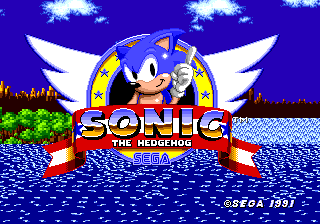
Game Revisions
The original release of the game lacked parallax scrolling, moving clouds (Green Hill Zone), rippling water (Labyrinth Zone), a correct Level Select screen arrangement, and other minor details. These effects were added in the later Japanese release, known as REV01. The much later "JP2" version found in Sonic Mega Collection was an officially hacked ROM which "fixed" the "Spike Bug".
Hivebrain has documented the changes between the first version and the newer Japanese version, which is provided below:
- "clr.l" used instead of "move.l #0" in ClearScreen.
- Garbage removed from CalcSine.
- "TM" on Sega screen is hidden if the console is Japanese.
- "TM" on title screen isn't loaded if the console is Japanese.
- AddPoints gives you an extra life for every 50000 points.
- Level select stage order is correct.
- Level select code is UDDDLR (instead of UDLR) if the console is Japanese.
- Moved restart level flag check in Level_MainLoop.
- Added background scroll check to LZWaterFeatures.
- d2 is cleared in a slightly different way in MoveSonicInDemo.
- Added gamemode check in SS_MainLoop.
- Tidied EndSTH (obj89).
- Layer scrolling changed.
- Tile drawing changed.
- Stuff added to DLE_MZ1.
- Blank frame added to rings mappings [1].
- Added check in monitor contents item to prevent interruption of drowning music [2].
- Lamppost time is cleared after game over (obj39).
- Tidied MarbleBrick (obj46).
- Tidied FloatingBlock (obj56).
- Minor change to DrownCount (obj0A).
- Changes to Caterkiller (obj78).
- Minor change to Labyrinth boss (obj77).
- Minor changes to Final boss (obj85), including 1000 point bonus for killing it.
- Ending sequence debug list changed.
- Some unneeded things removed from Pattern Load Cues.
- Sega logo graphics and mappings slightly different.
- Unused graphics data removed.
- MZ & SBZ 256x256 tiles modified.
- SS5 & SS6 layouts modified.
- SYZ background modified.
- Minor change to SolidObject subroutine [3].
GoodGen Version Index
- Sonic the Hedgehog (W) (REV 00) [!] - The standard first release of Sonic 1.
- Sonic the Hedgehog (W) (REV 01) [!] - Japanese-only version of Sonic 1, with graphical enhancements.
- Sonic the Hedgehog (W) (REV XB) - Release with graphical enhancements and with the spike-bug fixed.
- Sonic the Hedgehog (W) [p1][!] - Pirate version of Sonic 1, with copyrights, logos and serial number removed.
- Sonic the Hedgehog (W) [p2][!] - Pirate version of Sonic 1, with copyrights and logos removed.
Rereleases
- Sonic the Hedgehog (arcade game) for Mega-Tech and Mega Play
- Sonic the Hedgehog for Tiger LCD (1991)
- 6-Pak for the Sega Genesis (1996)
- Sonic Classics for the Sega Genesis (1995)
- Mega 6 Volume 3 for the Sega Genesis (1995)
- Sonic Jam for the Sega Saturn (1997)
- Sega Smash Pack Vol. 1 for the Sega Dreamcast (2000)
- Sonic Mega Collection for the Nintendo GameCube (2002)
- NOTE: Sonic Mega Collection contains the original western release, the Japanese revision and "JP2" ("spike bug fix") available to play.
- Sonic Mega Collection Plus for the Sony PlayStation 2 and Microsoft Xbox (2004)
- Sega Genesis Collection Volume 1 for the Play TV Legends (2004)
- Super Sonic Gold for the Play TV Legends (2004)
- Sonic the Hedgehog (2005 Sonic Cafe) for iMode phones (2005)
- Sonic Mega Collection Plus & Super Monkey Ball Deluxe for the Microsoft Xbox (2005)
- Sonic the Hedgehog Mobile for iMode phones (2006)
- Sonic the Hedgehog Genesis for the Game Boy Advance (2006)
- Sonic the Hedgehog (Microsoft Live Arcade) on Microsoft Live Arcade (2006)
- Sega Genesis Collection on Sony PlayStation 2 and PlayStation Portable (2006)
- Virtual Console on Nintendo Wii (2006)
- Sonic the Hedgehog (iPod) (2007)
- Sega Fun Pack: Sonic Mega Collection Plus & Shadow the Hedgehog for the Sony PlayStation 2 (2009)
- Sonic's Ultimate Genesis Collection for the Sony PlayStation 3 and Xbox 360 (2009)
- Sonic the Hedgehog (iPhone) for Apple iPhone and iPod Touch (2009)
- Sonic PC Collection for the PC (2009)
- Sonic Classic Collection for the Nintendo DS (2010)
- Sega Mega Drive Classic Collection Volume 1 (2010)
- Sonic the Hedgehog (Android) for Android mobile phone handsets (2011)
Resources
ROM Modification
Disassemblies
Disassemblies are like source codes. You can modify them how you want, reassemble them, and play it. Even though the ROM will be shifted, it will work because of labels.
- Complete list of Sonic 1 disassemblies
- View the disassembly on the SVN
- Download the complete disassembly direct from the SVN
Hacking Guides
- Sonic Community Hacking Guide/Sonic the Hedgehog
- Nemesis' Sonic 1 ROM Hacking Guide
- Nemesis' Sonic 1 Savestate Hacking Guide
Image Galleries
Physical Scans
| Mega Drive, US (Classic) |
|---|
Artwork
See Also
- Sonic the Hedgehog Story Comic - A three volume comic released in Japan used to advertise the game. Contained in the narrative are elements there were eventually changed or removed from the final product.
- Sonic the Hedgehog (promotional comic) - A standalone story commissioned by Sega of America using the westernized story no longer considered canon.
External Links
- http://www.theghz.com/sonic/son1/son1.html - The page for Sonic the Hedgehog on The Green Hill Zone.
- http://www.soniczone0.com/games/sonic1/backgroundinfo/ - A detailed look at the game Sonic the Hedgehog on the site Zone: 0.
| Sonic the Hedgehog (16-bit) | |
|---|---|
|
Main page (Gen|2013|3D|Ages) Manuals Development |
show;hide
Scrapped Enemies: |
| Sonic the Hedgehog games for the following systems | |
|---|---|
| |
1991 Sonic the Hedgehog | Sonic Eraser 1992 Sonic the Hedgehog 2 1993 Sonic the Hedgehog CD | Dr. Robotnik's Mean Bean Machine | Sonic Spinball 1994 Sonic the Hedgehog 3 | Sonic & Knuckles 1995 Chaotix | Sonic Classics 1996 Sonic 3D: Flickies' Island |
